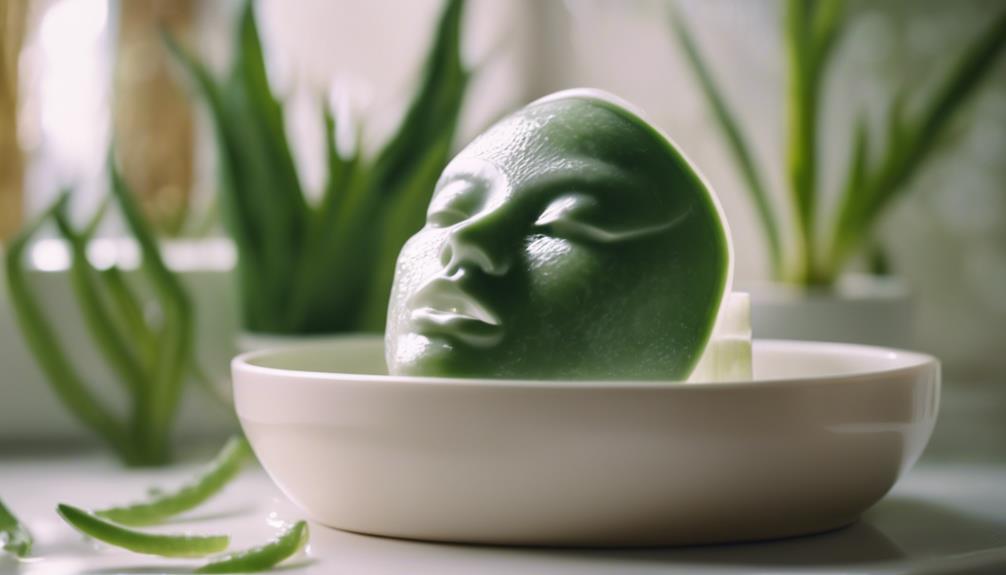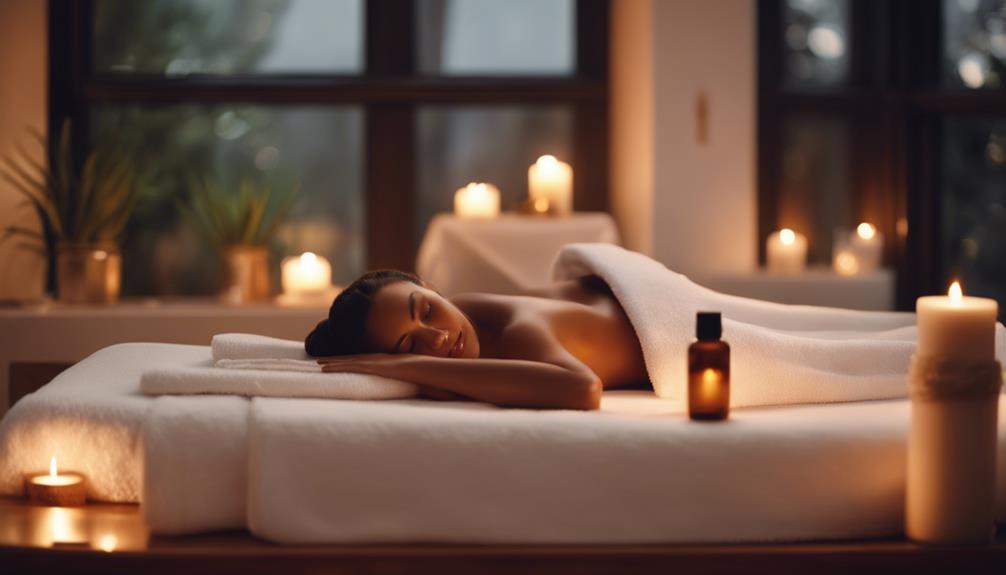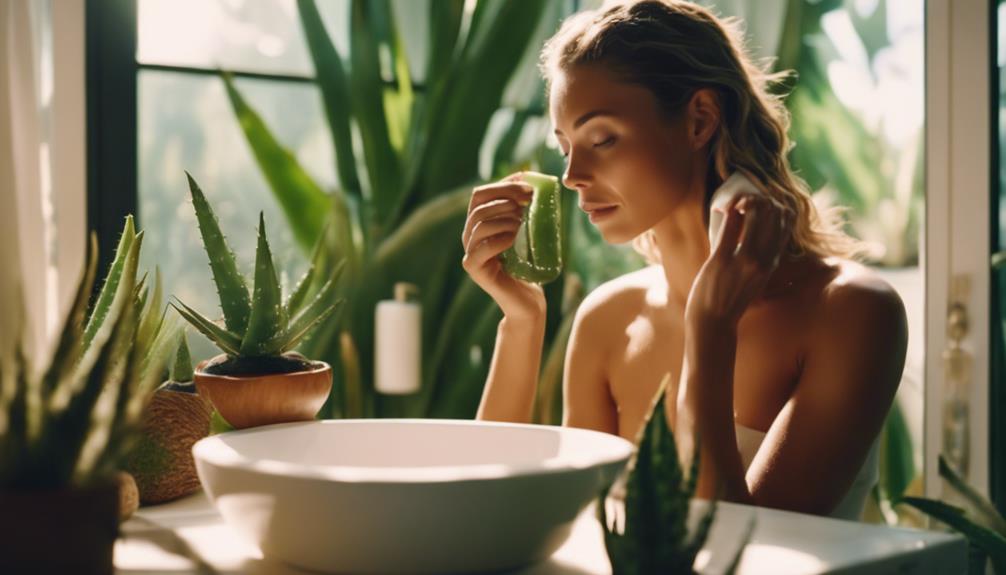To revitalize your skin after tanning, hydration is key. Start by drinking plenty of water and applying a rich post-tan moisturizer with hyaluronic acid or aloe vera to lock in moisture. Don't forget daily sunscreen with at least SPF 30 to protect your skin from UV damage. Exfoliate 1-2 times a week for an even glow and consider antioxidants like vitamins C and E to promote healing. Nourish your skin from within by eating fruits and omega-3s. By following these steps, you can regain vibrancy and health—there's much more you can discover about maintaining that glow!
Key Takeaways
- Immediately hydrate your skin with a rich post-tan moisturizer to lock in moisture and prevent dryness.
- Incorporate a daily broad-spectrum sunscreen of at least SPF 30 to protect your skin from further UV damage.
- Exfoliate 1-2 times weekly to promote an even skin tone and enhance your tan's vibrancy.
- Consume a diet rich in fruits and omega-3s to nourish your skin from within and support its recovery.
Post-Tan Skin Care Essentials
To keep your skin glowing and healthy after tanning, prioritize hydration and moisturization right from the moment you step out of the tanning bed.
Apply a moisturizer specifically designed for post-tan care immediately after showering to lock in moisture and maintain your tan's vibrancy.
Don't forget to use sunscreen daily with at least SPF 30, even for brief outdoor exposure, to protect against UV damage.
Exfoliate your skin 1-2 times a week to guarantee an even tone and enhance your glow.
Incorporate a diet rich in fruits and omega-3s to nourish your skin from within.
Staying consistent with these essentials will help prolong your tan and keep your skin looking its best.
Importance of Hydration
Maintaining hydration is key to preserving your tan and ensuring your skin looks radiant and healthy. When you tan, your skin can lose moisture, leading to dryness and flakiness.
To combat this, drink plenty of water throughout the day to keep your skin hydrated from within. Incorporate moisturizers containing hyaluronic acid or aloe vera, which deeply hydrate and soothe your skin.
Applying these products right after showering locks in moisture, enhancing your tan's longevity. Don't forget to nourish your skin with a diet rich in fruits and omega-3s, as they promote overall skin health.
UV Protection Strategies

It's essential to incorporate effective UV protection strategies into your daily routine to safeguard your skin from harmful sun exposure.
Start with a broad-spectrum sunscreen of at least SPF 30, applying it every morning and reapplying every two hours when you're outdoors.
Don't forget to protect your eyes; wear UV-blocking sunglasses, even on cloudy days.
If you notice any redness or itching after tanning, apply a soothing moisturizer immediately.
Regularly monitor your skin for any unusual changes or reactions, as early detection is key to maintaining skin health.
Finally, consider wearing protective clothing, such as hats and long sleeves, to minimize direct sun exposure.
Taking these steps can greatly enhance your skin's resilience against UV damage.
Role of Antioxidants
Antioxidants play a significant role in repairing skin damage caused by UV exposure, helping to restore your skin's health and radiance after tanning. Incorporating antioxidants into your routine is essential for effective recovery.
Here are some key benefits:
- Neutralize Free Radicals: Antioxidants combat harmful free radicals generated by UV exposure.
- Enhance Skin Repair: Vitamins C and E in antioxidant-rich products promote skin healing and rejuvenation.
- Boost Hydration: Many antioxidants help retain moisture, keeping your skin supple and hydrated.
- Improve Skin Tone: Regular use can enhance your skin's overall appearance, giving you that desired glow.
Effective Facial Care

To keep your skin looking radiant after tanning, focus on using gentle cleansers and hydrating moisturizers tailored for post-tan care.
Mild cleansers prevent irritation and help maintain your skin's natural moisture balance. After cleansing, apply a rich moisturizer containing hyaluronic acid to lock in hydration. This will help combat dryness while keeping your tan vibrant.
Don't forget sunscreen! Even indoors, UV rays can penetrate windows, so apply a broad-spectrum SPF 30 daily.
Opt for non-comedogenic products to avoid breakouts, ensuring a glowy finish without greasiness.
Finally, consider incorporating an antioxidant-rich serum into your routine to further protect and nourish your skin.
With these steps, you'll keep your complexion healthy and glowing long after tanning.
Safe Tanning Alternatives
Looking for safe alternatives to achieve a sun-kissed glow without the risks of tanning beds? You've got plenty of options that keep your skin healthy and radiant.
Here are four popular alternatives:
- Self-Tanning Lotions: These offer an easy way to get a tan without UV exposure. Just apply and watch your glow develop!
- Tanning Sprays: Quick-drying and streak-free, these sprays provide an even tan in minutes.
- Bronzers: Instant gratification! Bronzers give you a temporary tan that washes off easily.
- Sunless Tanning Towelettes: Portable and mess-free, these towelettes allow for easy application on the go.
Embrace these safe tanning alternatives to keep your skin looking fabulous and healthy!
Tanning Bed Hygiene Tips

Maintaining proper hygiene in tanning beds is just as important as exploring safe tanning alternatives to protect your skin from potential risks. Before using a tanning bed, always wipe down the surface with disinfectant wipes. Use a towel to lay on the bed, ensuring a barrier between your skin and the equipment. After tanning, don't forget to clean your tanning bed again for the next user.
Here's a quick hygiene checklist:
| Action | Before Tanning | After Tanning |
|---|---|---|
| Wipe down the bed | Yes | Yes |
| Use a protective towel | Yes | No |
| Clean with disinfectant | No | Yes |
Following these steps will help keep the tanning experience safe and enjoyable for everyone.
Frequently Asked Questions
How Soon Can I Shower After Using a Tanning Bed?
You can shower about four hours after using a tanning bed. This allows your tan to develop properly. Just remember to use gentle cleansers to maintain your skin's hydration and avoid irritation.
Can I Use Makeup Immediately After Tanning?
You should wait at least a few hours before applying makeup after tanning. This allows your skin to absorb the tanning product and helps prevent irritation. Always prioritize hydration and use non-comedogenic makeup for best results.
Is It Safe to Tan During Pregnancy?
Tanning during pregnancy is like walking a tightrope; caution is key. It's best to avoid tanning beds and excessive sun exposure, as your skin's sensitivity can increase, potentially affecting both you and your baby's health.
How Long Does a Tan Typically Last?
A tan typically lasts about 7 to 10 days, depending on your skin type and care routine. To extend it, keep your skin moisturized, hydrated, and protected from sun exposure.
Can I Use Self-Tanner on Top of a Tanning Bed Tan?
Imagine a painter adding layers to a masterpiece. Yes, you can use self-tanner over a tanning bed tan, but make certain your skin's well-hydrated first. This way, your canvas remains vibrant and beautifully blended.
Conclusion
Incorporating these post-tan skincare tips can truly make a difference in how your skin looks and feels.
By staying hydrated, protecting against UV damage, and using antioxidants, you'll not only maintain your sun-kissed glow but also enhance your skin's health.
Isn't it worth the effort to keep your skin radiant and vibrant?
Remember, a little care goes a long way, so embrace these strategies and enjoy your stunning complexion for longer!









